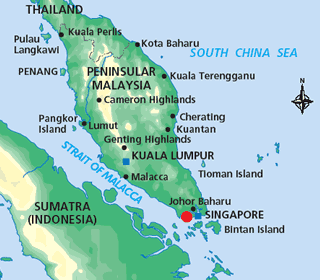The Singapore Environment - Blog Action Day
By Murray Bourne, 15 Oct 2007
In my contribution to Blog Action Day, I will talk about challenges facing the Singapore environment.
For those of you who have never been to this part of the world, Singapore is a small island off the southern tip of Malaysia:
Environmental Issues facing Singapore
Indonesian forest fires, an almost annual event during the drier months of August and September, result from slash-and-burn farming methods. Lately, as the price of palm oil has escalated, more land is cleared to plant this supposed green alternative to oil. Please think twice before using palm-oil based fuels - it is quite possible that such an act produces a net increase in atmospheric carbon levels.
The worst year for the forest fire "haze" was 1997, our first year in Singapore. It was hot, dry and every day there was the choking smoke. Not good.
Global warming is a threat to all low-lying island countries. Most of Singapore is less than 3 m above sea level and experiences flooding in very strong monsoonal rain. Add a metre to sea levels and you have a serious problem.
Habitat destruction: Nearly all of Singapore's primary rainforest is gone. In Malaysia to the north (and Indonesia as already mentioned), vast swathes of rainforest have been cleared for housing, industry, agriculture (especially palm oil) and of course, timber.
Singapore's tiny land area has been augmented by land reclamation, but this has caused destruction of reefs and mangrove areas.
Population pressure: Singapore imports nearly all of its water and food. The population has increased from 3.5 million to 4.7 million in the last 10 years. The government recently indicated a 'target' of 6.5 million and almost all of the growth will come from immigration, since the fertility rate is just 1.26% (well below the generally accepted replacement level of 2.1%). Such growth will require the construction of more dwellings (since most foreigners will want to live in separate family units) and hence more destruction of green space for buildings and roads.
Cars: Singapore has a good system of restricting ownership of cars (see The Math of Car Ownership in Singapore). However, the growth in car usage is greater than population growth, in part because owning a car is seen as a status symbol. Many of my colleagues complain about increasing peak-hour jams.
I thought it was ironic that the announcement of an F1 race in the streets of Singapore came at the time of the global warming report from the UN - both items appeared on the front page of the Straits Times newspaper.
Final Thoughts
Even though Singapore has a well-deserved reputation for being a clean and green country, there are still many challenges facing Singapore's environment. Since its independence 42 years ago, there has been a concerted effort to plant trees, restrict the number of cars and promote public transport.
However, there is still a long way to go in the areas of recycling, reduction of airborne particulate matter, putting pressure on Malaysia and Indonesia to stop forest fires and car use.
See the 3 Comments below.


16 Nov 2008 at 6:01 pm [Comment permalink]
great post singapore is a great country and very green keep up the great work
17 Jan 2019 at 5:20 am [Comment permalink]
Picture a thin clear dome that encloses say 100 homes.
Air quality, humidity, and sunlight inside are optimized
It might be retractable to capture good weather days.
Singapore has the wealth, the engineers, and the government
to explore this technology.
If practical, there are polluted cities around the planet
that would line up as customers.
ct
17 Jan 2019 at 8:51 am [Comment permalink]
This actually reminded me of what the Japanese provide: Oxygen bars
Arguably, Singapore already does this with its multitude of air-conditioned high rise buildings where you cannot even open the window. (Having said that, you often see a dirty stain near the aircon outlet, so I suppose the filtering has a way to go in such cases.)